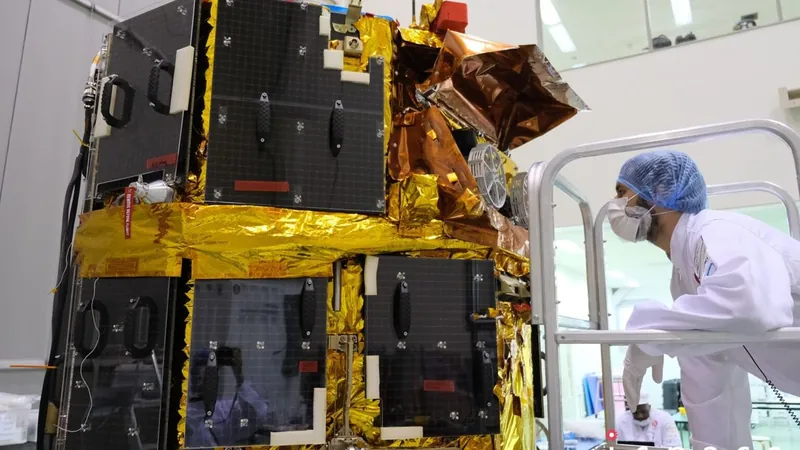
What's Riding to the Moon on ispace's Resilience Lunar Lander?
2025-01-14
Author: Arjun
What's Riding to the Moon on ispace's Resilience Lunar Lander?
In an exciting leap forward for lunar exploration, Japanese space exploration company ispace is ready to launch its second lunar lander, dubbed "Resilience." Set to take off early Wednesday morning, January 15, at 1:11 a.m. EST from NASA's Kennedy Space Center in Florida, this mission is part of an ambitious plan for a series of lunar launches kicking off in 2025.
Riding aboard a SpaceX Falcon 9 rocket, the Resilience lander is an evolution of ispace's Hakuto-R solar-powered platform. Shaped like an octagonal prism, it stands 7.5 feet (2.3 meters) tall and 8.5 feet (2.6 meters) wide, underpinned by four sturdy landing legs designed for its delicate interactions with the lunar terrain.
But what’s especially thrilling about this mission is what the Resilience will be carrying to the lunar surface. It’s equipped with five scientific payloads, a mix of contributions from various commercial and academic partners. Notably, a micro rover named "Tenacious," built by ispace’s subsidiary in Luxembourg, will undertake the pivotal task of initial resource exploration on the Moon.
Meet Tenacious: The Moon's Newest Explorer!
The Tenacious rover packs a punch despite its compact size, measuring just 10.24 inches (26 cm) tall and weighing about 11 pounds (5 kg). Its high-definition camera and small shovel will allow it to collect and analyze lunar samples. Additionally, Tenacious will be carrying a quirky art piece called "Moonhouse," a small red house framed in white, created by Swedish artist Mikael Genberg—an eye-catching homage to creativity in the harsh lunar environment.
Innovations for Sustainable Exploration
Among the scientific payloads on Resilience are groundbreaking experiments intended for potential long-term lunar habitation. The Water Electrolyzer Experiment, developed by Takasago Thermal Engineering Co., aims to demonstrate the production of oxygen and hydrogen from lunar water resources—essential for sustainable exploration.
Also on board is an algae-based food production module created by Euglena Co., which will test the viability of algae cultivation as a food source in space. This could have significant implications for future life support systems, potentially reducing the dependence on Earth-supplied food.
In addition, the Deep Space Radiation Probe (DSRP) will be monitoring radiation levels during the mission, providing essential data that will inform the safety of future human explorations on the Moon.
A Touch of Fantasy: The Gundam Commemorative Plate
Wrapping up the payload is a unique commemorative alloy plate inspired by the "Charter of the Universal Century," a fictional document from the beloved Japanese anime franchise, Gundam. Developed by Bandai Namco Research Institute, this item adds an imaginative flair to a very real mission.
Learning from the Past
Resilience's mission is particularly noteworthy as it incorporates lessons from ispace's previous attempt in April 2023, which ended in a crash due to an onboard sensor error. With enhanced technology and insights, ispace aims to lay the groundwork for future successes, including a larger lander named Apex 1.0 expected to launch in 2026.
As ispace embarks on this lunar adventure, all eyes will be on the sky come launch day, marking yet another chapter in humanity's quest for space exploration. Don’t miss out on the latest developments in this thrilling era of discovery!



 Brasil (PT)
Brasil (PT)
 Canada (EN)
Canada (EN)
 Chile (ES)
Chile (ES)
 Česko (CS)
Česko (CS)
 대한민국 (KO)
대한민국 (KO)
 España (ES)
España (ES)
 France (FR)
France (FR)
 Hong Kong (EN)
Hong Kong (EN)
 Italia (IT)
Italia (IT)
 日本 (JA)
日本 (JA)
 Magyarország (HU)
Magyarország (HU)
 Norge (NO)
Norge (NO)
 Polska (PL)
Polska (PL)
 Schweiz (DE)
Schweiz (DE)
 Singapore (EN)
Singapore (EN)
 Sverige (SV)
Sverige (SV)
 Suomi (FI)
Suomi (FI)
 Türkiye (TR)
Türkiye (TR)
 الإمارات العربية المتحدة (AR)
الإمارات العربية المتحدة (AR)